
eBook - ePub
Building the Timber Frame House
The Revival of a Forgotten Craft
Tedd Benson,James Gruber,Jamie Page
This is a test
Compartir libro
- 224 páginas
- English
- ePUB (apto para móviles)
- Disponible en iOS y Android
eBook - ePub
Building the Timber Frame House
The Revival of a Forgotten Craft
Tedd Benson,James Gruber,Jamie Page
Detalles del libro
Vista previa del libro
Índice
Citas
Información del libro
For centuries, post-and-beam construction has proved to be one of the most durable building techniques. It is being enthusiastically revived today not only for its sturdiness but because it can be easily insulated, it is attractive, and it offers the builder the unique satisfaction of working with timbers. Building the Timber Frame House is the most comprehensive manual available on the technique. In it you will find a short history, of timber framing and a fully illustrated discussion of the different kinds of joinery, assembly of timbers, and raising of the frame. There are also detailed sections on present-day design and materials, house plans, site development, foundation laying, insulation, tools, and methods.
Preguntas frecuentes
¿Cómo cancelo mi suscripción?
¿Cómo descargo los libros?
Por el momento, todos nuestros libros ePub adaptables a dispositivos móviles se pueden descargar a través de la aplicación. La mayor parte de nuestros PDF también se puede descargar y ya estamos trabajando para que el resto también sea descargable. Obtén más información aquí.
¿En qué se diferencian los planes de precios?
Ambos planes te permiten acceder por completo a la biblioteca y a todas las funciones de Perlego. Las únicas diferencias son el precio y el período de suscripción: con el plan anual ahorrarás en torno a un 30 % en comparación con 12 meses de un plan mensual.
¿Qué es Perlego?
Somos un servicio de suscripción de libros de texto en línea que te permite acceder a toda una biblioteca en línea por menos de lo que cuesta un libro al mes. Con más de un millón de libros sobre más de 1000 categorías, ¡tenemos todo lo que necesitas! Obtén más información aquí.
¿Perlego ofrece la función de texto a voz?
Busca el símbolo de lectura en voz alta en tu próximo libro para ver si puedes escucharlo. La herramienta de lectura en voz alta lee el texto en voz alta por ti, resaltando el texto a medida que se lee. Puedes pausarla, acelerarla y ralentizarla. Obtén más información aquí.
¿Es Building the Timber Frame House un PDF/ePUB en línea?
Sí, puedes acceder a Building the Timber Frame House de Tedd Benson,James Gruber,Jamie Page en formato PDF o ePUB, así como a otros libros populares de Technology & Engineering y Technical & Manufacturing Trades. Tenemos más de un millón de libros disponibles en nuestro catálogo para que explores.
Información
Categoría
Technology & EngineeringCategoría
Technical & Manufacturing Trades
THE PAST

CHAPTER ONE
WITH BROADAXE AND ADZE A LOOK BACK
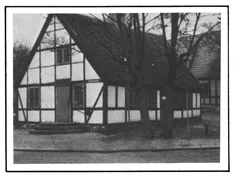
This carries us back to the time of the building of our old home, now more than fifty-five years ago; though only a lad we remember the time the trees were being felled in the forest and, after a long wait for the timbers to be squared, they were hauled to the building site, and, after a time for them to season, the carpenters came and, as though but yesterday, we see them under the old apple trees astride the timbers with auger, chisel and mallet working away from morn till night…. Those were days of toil, days of contentment and peace.
—Radford: Audels Carpenters and Builders Guide, 1923
ACCORDING to Jacob Bronowski, a turning point for man began when he developed the capacity and summoned the will to cut and to split materials to form his structures. It was the difference between aggressively probing the structure of elements and passively submitting to their raw forms. In this difference was a seed of curiosity and adventure that burst, and with it, the mind of man expanded, for the growth of the intellect and the constructive work of the hands are the stalk and root of civilization. Before the Iron Age, homes were merely crude shelter; only slightly removed from other species, man was resigned to digging into the earth or fashioning huts with woven twigs and branches. He lived in burrows and nests, not homes. But when iron was finally wrested from stone and tools were formed, man was able to step out of his primitive past, out of the nests and pits, and into structures that would begin to reflect and to support his bold destiny.
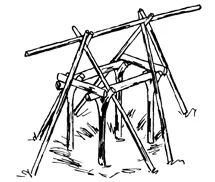
TATEANA DWELLING, JAPAN c. NEOLITHIC
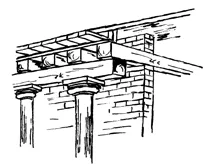
GREEK TEMPLE c. 500 B.C.
The first sharpened tools were probably directed toward the shaping of a most fundamental building material—wood. It was readily available, easily worked, and had already proven itself to be strong in earlier kinds of structures. So, timbers—the building unit closest to the tree itself—were the immediate choice for buildings that would now rise above the ground and start to show signs of permanence. What were built with those early tools and crudely shaped timbers were no longer just shelters but homes. They were now durable enough and functional enough to keep people settled in one area. This, in Kenneth Clark’s definition, was the beginning of civilization. It was also the beginning of a building system so primal and basic that it would find its way into the development of many cultures in all parts of the world, yet so formidable and subtle that it would avoid mastery for many centuries.
If we mark the start of timber-frame construction with the fashioning of the first joints, it began around 200 B.C. Archaeological studies show that this development was simultaneous in the Far East and in Europe. And in both cases, the shapes of the first timber buildings had descended from earlier huts formed by lashing poles together over shallow pits. These huts had evolved into elongated rectangular structures with repeated central supports forming a series of bays. With a few modifications, this was a system perfectly suited to the joining of timbers, and it continues to be the fundamental design principle for timber-framed buildings today.
Right from the start, man showed an affinity to working with wood, to building with timbers. The individuality and the variety of wood maintained his curiosity; its humble acquiescence to his simple tools gave him satisfaction. Between the walls of these substantial buildings, there was security enough to release the caged and dormant portions of the mind. Therefore, greatly dependent on his construction methods, man sprinted into the future, falling many times in pursuit of an obscure goal. The development of timber framing, then, closely followed the rise and fall of numerous civilizations. There will not be an attempt here to encompass that history; it would fail and also miss the point of this book. Instead, we’ll glance back and try to develop a feel for the full and sturdy past that forms the reference for our work with timbers today.
Though the origins of timber framing were early in the history of man, they were not necessarily primitive in form. Some of the greatly admired stone temples of Greece once stood as a similar network of carefully arranged and simply joined timbers. An historian in the second century A.D. wrote that Heraion at Olympia had one remaining wood column, the last of forty to be replaced with stone. When stone took the place of the wood that preceded it, the architecture necessarily became more massive, more monumental, in order to support the weight and reduce the spans of beams that were heavy and strong but not resilient. Because of their flexibility, wooden beams were able to make longer spans and columns didn’t need to be so large. Perhaps this is why the vase painters of classical Greece depicted buildings much more airy and graceful than the stone structures that actually existed.
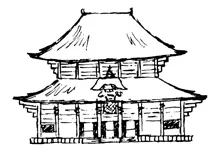
JAPANESE TEMPLE
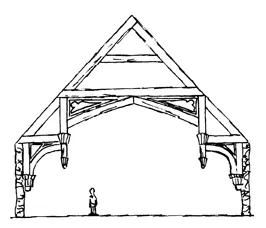
HAMMER-BEAM TRUSS
Farther east, in India, the same pattern was repeated—stone buildings having been the monumental duplicates of their wooden predecessors. With the help of this relationship, archaeologists have dated Indian timber-frame construction to 200 B.C. Timbers were shaped from teak and connected with simple joinery and bamboo pegs. But there was nothing primitive about the richly ornate and highly refined buildings that are believed to have been built with these simple methods.
During this same period, the craft of joining timbers was beginning to flower in another Eastern country—Japan. The Japanese, too, were putting their finest efforts toward the building of shrines and temples. But these were not destined to be replaced with stone. Japan has a history of being subjected to typhoons and earthquakes, and the builders quickly discovered that there were distinct advantages to the fibrous timbers and the hingelike joints that connected them. If a building constructed from stone or brick wiggles a bit, it will crack or break; if made of timbers, it only shrugs. So the Japanese carpenters dedicated themselves to finding the answers to the mysteries of working timbers. By the sixth century, with the help of immigrant Chinese Buddhists, their achievements in wooden structures were unrivaled. In 679 the Golden Hall was built, and in 693 the Pagoda. They both still stand, the oldest surviving wooden structures in the world.
If Japanese carpentry was highly evolved, it was also fiercely competitive. The craft was developed within a family guild system that maintained tight security over construction techniques and strict authority concerning procedure among its members. Intense rivalry between the two major guilds had the positive effect of keeping the standards high; a languid or sloppy attitude could not be tolerated in the heat of contest. But in the attempt to outdo one another, these guilds often produced joints much more puzzling than they were effective. Still, they developed over four hundred joints, and many are still in use today. Japanese tradition has also given modern carpenters a special appreciation for their tools. The word that describes them, Dōgu, translates to “the instruments of the way.” Because Japanese carpenters are aware of all that has been accomplished with these instruments, they remain reluctant to relegate them to mere tools.
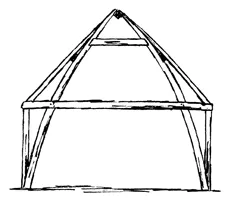
ENGLISH CRUCK
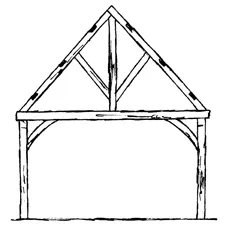
ENGLISH BOX FRAME
Closer to our own roots, in Europe, the evolution of timber framing was slower to mature, but when it came of age, it showed elements of sophistication and refinement previously unknown. As in Japan, there were well-organized and powerful guilds that maintained uniform high standards. But they were singular and without rivalry. Absent was the disparity from competition, and because of it there was unity and a bent toward the utilitarian. In that light, European craftsmen were able to discover the simple answers to seemingly complex problems. These were the people who built graceful roof trusses able to span sixty feet or more, entirely constructed of short timbers. And they were the ones who fashioned the vaulted ceilings so famous in the magnificent cathedrals. They found ways to use angled braces not only for stability but also for ornament. When the upper class demanded extravagance, they received ornately carved embellishments in timbers joined in complex patterns, fit even for the most fastidious of lords.
But in timber framing’s humble beginnings, there was no adornment; there was only a naturally curved tree, split lengthwise, with the halves inclined toward each other and joined at the peak. That was a “cruck” (see Glossary). When two or more of these crucks were connected, they formed a primitive frame. In a later refinement, a crossbeam was used to brace them and walls were built from the ends of the crossbeams to the base of the cruck. Finally, for lack of suitably bent trees, vertical posts were added and the cruck was reduced to simple rafters. Since it was no longer curved like a cruck (from crook), this new refinement was called a box frame. The simple elements of this box frame have been the basis for almost all the timber-framed structures that have followed.
The Norsemen, from northern Europe, were among those influenced by these developments. During the Viking era, they brought home some knowledge of the construction work being done by the English and French. When they combined this knowledge with their own ingenious shipbuilding skills, they were soon building lofty timber-framed sanctuaries—monumental and difficult. In building these famous “stave churches,” which numbered over seven hundred at one time, many construction problems were solved. From the twenty-five still standing, we can see how they rise in a tier effect, with a central roof surrounded by narrower, lean-to roof surfaces and topped with towers. The result is impressive.
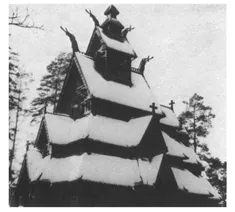
Courtesy of Chris Madigan
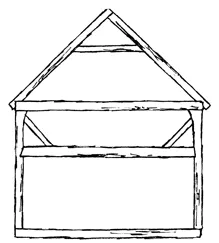
EARLY COLONIAL BENT c. 1600-1700
To make the open frames livable buildings, carpenters and masons in other European countries and the British Isles commonly filled in between the timbers with bricks, plaster, or a plaster-and-stick composite called wattle and daub. This system would seem to offer almost no merit: the infilling was heavy, putting undue stresses on the frame; and brick and plaster have almost no insulation value. With every sigh or sag in a constantly shifting and breathing frame, there would be a new crack to fill; furthermore, the posts and beams of the structure itself were subjected daily to the ravages of the weather. Despite these shortcomings, the English Tudor buildings and the French manor houses, so constructed, are revered around the world as models of architectural elegance. And, truly, the white filling behind the dark frame produces clean lines and appealing contrast.
When the first European colonists set foot in the New World, they took a step backward in time. The wealth of virgin resources was spread resplendent before their eyes, but the fruitful rewards lay beyond the walls created by their lack of tools and skill and the bitter reality of a harsh New England winter. Immediate shelter was desperately needed; those who struggled through the ravages of the first few winters made their stand from crude pits covered with thatch and turf. Therefore, the history of timber framing in this country repeated the entire history of the craft from its Iron Age origins.
The experience of the first few winters was costly and cruel for many settlers, but through it they learned important lessons about the New World; more important, they learned to appreciate their own ability to adapt and experiment. In a sense, it helped them to sever their bonds with the Old World. Therefore, as timber framing developed in this country, those who practiced it naturally reached back to the mother countries for the age-old guidelines, but they took only what was needed and then moved in separate directions.
From humble origins, and with no kings or lords to please, the colonists first cleaned from the frames most of the embellishments, of which they had no need. Before they left England, they might have witnessed the impasse of the master joiners, who had so completely mastered the wooden joining methods that the only...